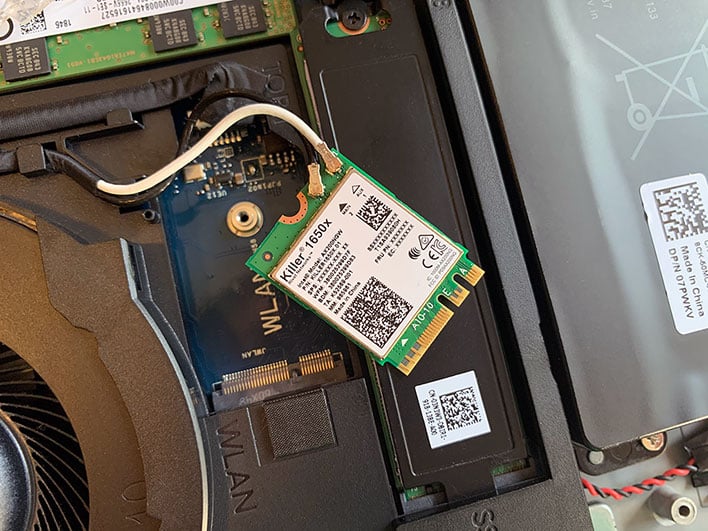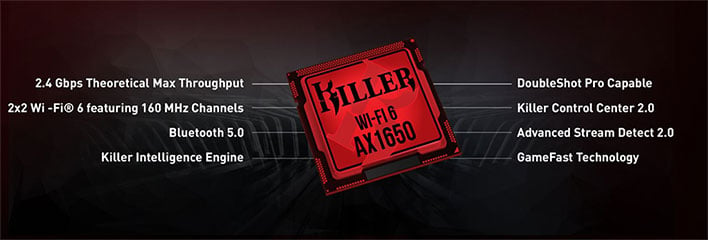Killer Wi-Fi 6 AX1650 Review: Ultra Fast, Affordable Next-Gen Wi-Fi
Killer Wi-Fi 6 AX1650: Uncorking Next-Gen Wireless Networking
Over the past few months, we have seen a spattering of Wi-Fi 6 (802.11ax) routers enter the fray, including the ASUS ROG GT-AX11000 and Netgear Nighthawk AX8, both of which we recently put to the test. There was a caveat to our testing, however—we had to benchmark them using Wi-Fi 5 (802.11ac) hardware, because at the time, Wi-Fi 6 had not yet really permeated the marketplace on the client side. That's to say, practically every modern device with Wi-Fi connectivity is sporting a Wi-Fi 5 adapter.
In a sense, companies like ASUS and Netgear had put the cart before the horse. It is not that these companies are obtuse. Rather, they recognized where the market was headed and essentially got a jump on what had been next-gen wireless connectivity. It is no longer a next-gen standard, though, with the Wi-Fi Alliance having recently rolled out an official Wi-Fi 6 certification program.
So technically, Wi-Fi 6 has now arrived, just not in earnest. It is a tiny snowball on top of a wireless mountain, overlooking a village of Wi-Fi 5 households. Things are about to change, though, because Rivet Networks and Intel are each making Wi-Fi 6 adapters broadly available, both as standout features in the newest laptops (and eventually desktops), and as standalone receivers that users can purchase and install inside their current notebooks. That tiny snowball has begun rolling down the mountainside and is beginning to gain momentum.
In a sense, Rivet Networks is hitching a ride on Intel's sled down that same mountainside. Its new Killer Wi-Fi 6 AX1650 wireless adapter is based on the same Wi-Fi 6 chipset and driver stack as Intel's own module, but on the software side, Rivet Networks amps things up with its own custom features, tweaks, and technologies. What some may find surprising is the lack of a significant markup on the Killer hardware—it sells for just $35 on Amazon, making it an affordable upgrade option.
That is in stark contrast to some of the early Wi-Fi 6 router options. The ASUS ROG Rapture GT-AX1100 and Netgear Nighthawk AX8 sell for $449.99 and $399, respectively, on Amazon. Pricing for Wi-Fi 6 routers will become affordable in time, but on the adapter side, Rivet Networks has done gamers (and consumers in general) a giant solid.
So, what exactly are we looking at here? Let's start with a rundown of the specs...
|
| Wi-Fi Technology |
2x2 Wi-Fi 6 (802.11ax) UL and DL OFDMA (Orthogonal Frequency Division Multiple Access) 20/40/80/160MHz channel support |
| Data Rate | 2.4Gbps |
| Chipset |
Intel |
| WLAN Frequency Band |
5GHz and 2.4GHz |
| Module Options |
AX1660x: M.2, module size = 22mm x 30mm AX1650i: M.2, module size = 22mm x 30mm (leverages integrated MAC) AX1650w: M.2, module size = 12mm x 16mm soldered down AX1650s: M.2, module size = 12mm x 16mm solder down (leverages integrated MAC) |
| Bluetooth | Bluetooth 5.0 |
| Security | WPA and WPA 2 Personal and Enterprise; WPA3 (pending OS support) |
| Authentication | 1X EAP-TLS, EAP-TTLS/MSCHAPv2, PEAPv0-MSCHAPv2 (EAP-SIM, EAP-AKA) |
| Encryption |
64-bit and 128-bit WEP, TKIP, 128-bit AES-CCMP, 256-bit AES-GCMP |
| Wi-Fi Direct Encryption |
WPA2-PSK, AES-CCMP |
| Price | $35 @ Amazon |
The AX1650 is a small M.2 module that is available in a few different variants, including a traditional 22mm x 30mm card (which we have in-house). There is also a smaller version available for OEMs that can be soldered inside a laptop, mini PC, or some other device.
While the M.2 interface is familiar, Killer warns it should only be used in laptops. It's not going to work if you plug it into an M.2 port in a desktop PC. Give it time and we may see a Killer PCI Express card (some off-brand Wi-Fi PCIe cards have already infiltrated Amazon), there just is not one right now.
Before we go any further, let's take a moment to talk about Rivet Networks as a company, and the Killer branding, which has been around for over a decade. The industry's first introduction to a Killer product came in 2006, with the first Killer NIC. At the time, Killer products were being marketed and hyped by Bigfoot Networks, and the lofty claims did not always translate to real-world experiences that were worth the cost of a pricier NIC. Sill, the company's efforts helped push the idea that advanced traffic shaping technology could potentially benefit enthusiasts and especially gamers.
Rivet Networks is billing the Killer Wi-Fi 6 AX1650 as the "first Wi-Fi 6 module specifically designed to deliver the fastest gameplay, the best streaming, and the most immersive communication experiences." Note that "gameplay" is the first point of focus. That is not by accident, as Rivet Networks has gamers squarely in its sights.
Much of that boils down to the software, and we will cover those aspects in a bit. As for the hardware, this is a dual-band, 2x2 Wi-Fi 6 module with support for 160MHz channels and Bluetooth 5.0. On the 5GHz channel, the maximum theoretical throughput is 2.4Gbps.
Here are the speed claims...
- Up to 3X more throughput than previous generation 80MHz 2x2 AC devices
- Up to 40 percent more throughput than previous generation 160MHz 2x2 AC devices
- Up to 4X more network capacity in dense environments than previous generation wireless AC networks
Faster throughput is one of the advantages of Wi-Fi 6, but not the only one. It is also better equipped to handle multiple simultaneously connected devices (even more so than MU-MIMO on Wi-Fi 5 hardware) and has the potential to lower latencies, to boot.
Rivet Networks
Before we go any further, let's take a moment to talk about Rivet Networks as a company, and the Killer branding, which has been around for over a decade. The industry's first introduction to a Killer product came in 2006, with the first Killer NIC. At the time, Killer products were being marketed and hyped by Bigfoot Networks, and the lofty claims did not always translate to real-world experiences that were worth the cost of a pricier NIC. Sill, the company's efforts helped push the idea that advanced traffic shaping technology could potentially benefit enthusiasts and especially gamers.
Networking stalwart Qualcomm Atheros acquired Bigfoot Networks in 2011, and then in 2014, it was spun out into a new company called Rivet Networks. That is the short version, anyway. For an more in-depth look at Rivet Networks, check out our Q&A with the company from a few years ago.
One of the takeaways from that Q&A is that Rivet Networks acknowledged its original Killer NIC from 2006 was expensive when it launched, and for many users the biggest issue was the pricing—the original Killer NIC launched at $279, which is around $355 today if you factor in inflation. That was a tough sell.
"We listened. When we left the offload chip design for a gigabit Ethernet controller, we completely changed the cost structure. While Killer used to be expensive years ago, it is now very comparable to other standard networking solutions. Getting this cost structure right was critical for the growth we have had over the last few years, and now users can go pick a system that has our technology and get all the great benefits without spending the price premium they would have had to spend years ago," Rivet Networks said at the time.
That's not lip service, at least not in regards to the Killer Wi-Fi 6 AX1650 adapter. At $35, the latest Killer adapter cannonballs into affordable territory, and is a far cry from the wild premium that was attached to the original Killer NIC.
Quick history lesson out of the way, let's take a closer look at the features and performance of the Killer Wi-Fi 6 AX1650...











